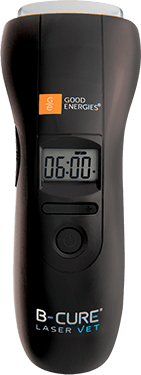Gingivitis, Periodontitis, Stomatitis
Watch the 3-min video treatment guide:
Periodontitis
Oral hygiene includes not only taking care of teeth but also gums. Inflammation of the gums can affect not only your teeth but also the general health of your entire body, which can induce pain, suffering and require many varied treatments. With this safe and easy-to-operate, home treatment, B-Cure Vet Laser increases the production of enzymes that fight inflammation and reduce pain and the harm caused by free radicals.
Gingivitis
Gingivitis in dogs and cats is an inflammation of the gums and the early stage of a gum disease called periodontal disease. It’s very common in dogs and is treatable. Although, if left untreated, it can develop into advanced periodontal disease, which can lead to teeth loss.
Gingivitis is caused by bacteria that accumulate due to plaque and tartar buildup. The inflammation of the gums may become more severe and painful, and the gums may even start to bleed.
What Is the Function of Gums?
Gums are the soft tissue surrounding the teeth, forming a sealing mechanism that binds the teeth to the underlying jawbone.
The most important role of the gums is to maintain the positioning of the teeth within the oral cavity.
Poor oral hygiene can lead to bacterial development and cause inflammation of the gums, which may lead to recession of the gums, pain, and damage to their holding capability, resulting in the loss of teeth.
Besides the damage caused to the teeth, the gums are the only point of exposed tissue in the body that is not totally sealed. In other words, bacteria, toxins, and other infectious matter can penetrate the connective fiber between the gums and the teeth, which in addition to harming the gums, may also enter the bloodstream, potentially affecting the entire body.
How Does Inflammation of the Gums Develop?
Dental plaque or tartar builds up around the teeth caused mainly by poor oral hygiene. The tartar collects and serves as a convenient platform for germs and toxins that cause inflammation and irritation.
In some cases, there is evident recession of the connective tissue between the gums and the teeth, while the upper part of the soft tissue remains in place. In this type of situation, a pocket is created between the gums and the teeth preventing the effective removal of germs, even after brushing, which can lead to the accumulation of germs and toxins in the pocket, which in turn produce inflammation.
Lack of treatment in a condition of gum inflammation can lead to gum recession, which exposes areas of the teeth, that are not intended to be exposed. This exposure causes sensitivity to hot and cold, to touch, and even to certain types of food. In extreme cases, it can cause tooth loss.
Research shows that inflammation of the gums not only harms teeth but can also enable germs to enter the body. This can cause harm to those with chronic diseases, induce early labor and cause low weight in newborns, lead to cardiac damage, promote dementia, harm diabetic balance, and may impair the body’s immune system. Healthy gums serve as a “Gatekeeper” and do not allow germs or their byproducts to enter the body.
Methods of Treatment and Prevention
This is preventable in dogs and cats with regular, at-home teeth brushing and occasional professional teeth cleanings, just as it is in humans. Many dog owners, however, do not give enough thought to their dogs’ dental health until it’s too late.
Treating Gum Inflammation with Low-Level Laser – B-Cure Laser Vet
For those who suffer from chronic tooth infections, dentists recommend low-level laser treatment. Today this can be done at home, on a daily basis, using the B-Cure Laser Vet.
Treatment using a low-level laser helps reduce and halt the process of gum inflammation. The low-level laser increases the release of anti-inflammatory enzymes and helps the body in its natural healing process. B-Cure Laser offers treatment at home with a low-level laser, with a compact, portable and easy-to-use device. The first treatment begins with 1.5 minutes for each point of treatment, gradually increasing the duration to 8 minutes, twice a day, for a period of at least two weeks.
Low-level laser has been clinically proven as an effective treatment for gum inflammation. A study carried out in 2015 proved that B-Cure Laser led to the substantial reduction of inflammatory germs in the oral cavity (killing over 60% of the germs).
Advantages of Treatment with B-Cure Laser
- Helps reduce pain and swelling
- Speeds up the healing process
- Reduces consumption of drugs
- User-friendly for home use: lightweight, portable, and rechargeable
- Scientifically proven – over 2,000 studies all over the world prove that low-level laser is safe and effective for all family members.
Start with a dosage of 1.5 minutes on each of the spots shown below and gradually increase the duration of the treatment up to 4 minutes within 24 hours.
Treat the following locations:
a. 4 minutes along the outside of the mouth near the upper premolars.
If there is also a problem in the lower gums:
b. 4 minutes on the jaw by the lower molars.
For those who suffer from stomatitis:
c. 4 minutes where the teeth end to reach the back of the throat.




